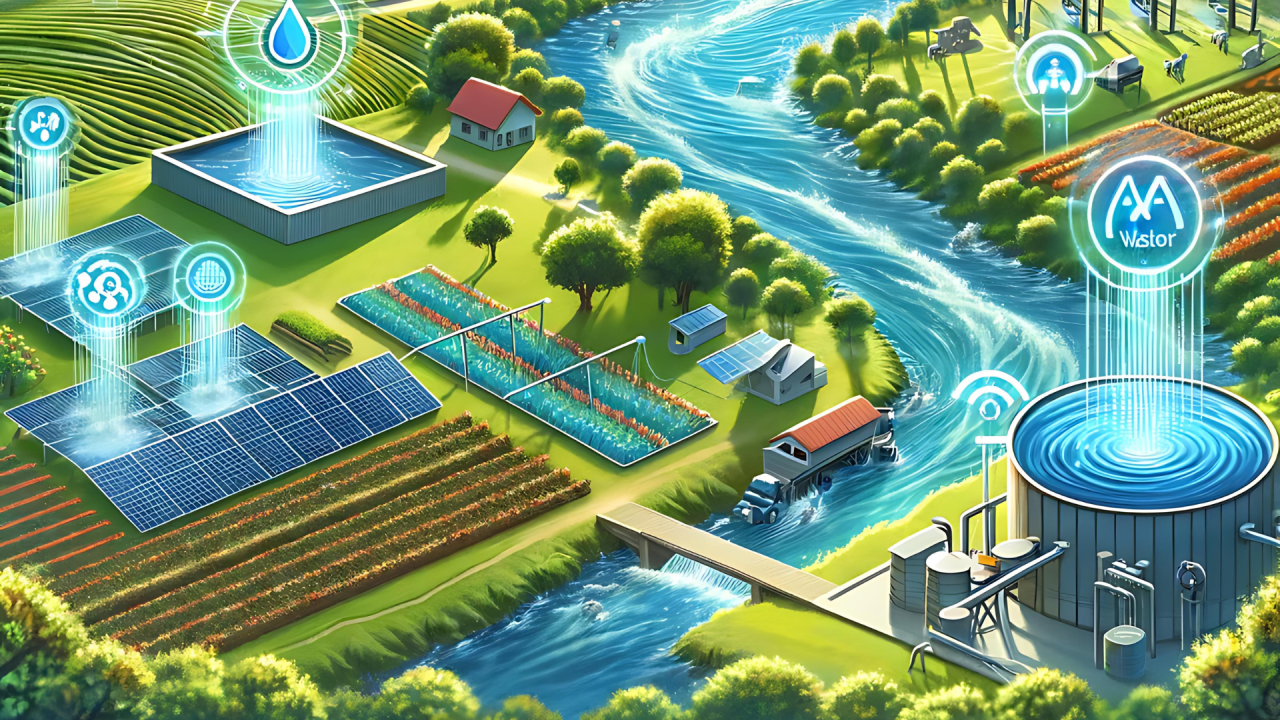Water management is a critical global challenge, especially with increasing urbanization, climate change, and growing demands for water resources. The integration of big data technologies into water management systems oers immense potential for enhancing the eciency, sustainability, and resilience of water resources. In particular, the widespread adoption of Big Data has the potential to revolutionize water resource management, expanding the possibilities of water-related work and altering the development of water systems to improve sustainability in both agriculture and metropolitan areas. management, challenges encountered in implementation and possible strategies to overcome the challenges.
Big Data is most easily understood as a large amount of complex data, which are generated from various sources, including sensors, satellite imagery, weather forecasts, water quality measurements, and consumption patterns. Of course, working with Big Data is not simple. While regular data might be easy for a single person to manage on a standard computing device, Big Data requires specialized software and hardware. Organizations need to invest in tools for data collection and cleaning, data storage solutions, and applications for analyzing and visualizing data. Increasingly, Big Data drives the adoption of artificial intelligence (AI) solutions. Additionally, because data is so valuable, organizations need to invest in robust cloud security solutions to protect any sensitive information contained in their datasets By harnessing big data, water management authorities can make better-informed decisions, predict future water-related events, optimize water distribution systems, and improve overall water resource governance. Forthcoming sections describe role of big data is reshaping the water datasets to identify patterns and trends that would otherwise go unnoticed. These insights can inform water policy decisions, such as adjusting irrigation schedules during drought periods or reallocating water resources to prevent shortages. Additionally, flood prediction models based on real-time data and weather forecasting can provide early warnings for vulnerable communities, enabling timely evacuations and infrastructure protection.
Data Collection and Monitoring
The advent of sensor technologies and IoT devices has significantly improved the real-time collection of data from water bodies, distribution systems, and consumption points. Advanced sensors placed in rivers, lakes, and reservoirs continuously gather data on water quality parameters such as temperature, pH, dissolved oxygen, turbidity, and pollutants. In parallel, weather stations and satellites monitor rainfall patterns, atmospheric conditions, and hydrological changes. This wealth of real-time data is critical for understanding water systems at a granular level, enabling immediate interventions and proactive decision-making.
Big data tools allow for the integration of these diverse data sources into unified platforms, where they can be processed, analyzed, and visualized. For example, continuous water quality monitoring helps detect pollution sources early, and hydrological sensors can provide early warnings for floods or droughts. This near-instantaneous data flow supports more timely and informed responses.
Water quality is another domain where big data has transformative potential. Water treatment plants and utilities benefit from real-time monitoring of water sources, ensuring compliance with environmental standards and public health safety. Big data enables the tracking of contaminants, such as heavy metals, chemicals, and pathogens, across vast networks. Machine learning and AI models can analyze water samples from multiple locations to detect emerging threats and recommend optimal treatment methods.
In urban environments, where water quality can be aected by pollution from industries, construction sites, and runo from streets, big data applications help track pollutants and recommend targeted actions for mitigation. Furthermore, predictive models can identify regions that are at high risk of waterborne diseases, allowing for precautionary measures and resource allocation. This data-driven approach results in safer, cleaner water for communities, while also reducing operational costs for treatment facilities.
Optimizing Water Distribution Systems
Big data enables utilities to optimize water distribution networks, reducing waste and improving eciency. By leveraging data from flow meters, pressure sensors, and consumer usage patterns, utilities can identify ineciencies in the system, such as leaks, unauthorized consumption, or environmental aspects of water use within a given region. Big data supports IWRM by enabling stakeholders to make datadriven decisions that consider multiple factors, such as land use, water availability, and ecosystem health. The ability to analyze vast amounts of data from multiple sources helps policymakers develop more comprehensive and coordinated management strategies.
For example, a regional government might use big data tools to evaluate the potential impacts of industrial development on local water resources. By analyzing data on industrial water usage, ecosystem health, and social needs, IWRM can identify solutions that ensure long-term sustainability. This integrated approach helps minimize water conflicts, optimize resource use, and promote environmental protection.
Predictive Analytics for Water Scarcity and Flood Management
Predictive analytics, powered by big data, plays a pivotal role in water resource management by forecasting future conditions and helping stakeholders prepare for potential water crises. By analyzing historical data, weather forecasts, soil moisture levels, and satellite imagery, big data tools can predict floods, droughts, or water scarcity events. For example, predictive models can help estimate water demand in specific regions or predict potential shortfalls in agricultural water supply based on changing climate conditions.
Advanced machine learning algorithms can process massive overuse in certain areas. Data analytics can also help with load forecasting, enabling utilities to allocate resources more eectively across the network, ensuring equitable water distribution.
For example, during peak demand times or drought conditions, water distribution systems can be adjusted dynamically, using predictive algorithms to direct water to regions with higher needs. This approach reduces energy consumption, enhances water conservation, and lowers costs for both utilities and consumers. Big data can also aid in infrastructure planning, by pinpointing areas that require maintenance or upgrades before they fail.
Managing Agricultural Water Use
Agriculture is one of the largest consumers of water globally. Ecient management of water resources for irrigation is therefore critical for both agricultural productivity and sustainability. Big data can help optimize irrigation schedules, predict crop water requirements, and minimize water wastage. Through the use of soil moisture sensors, weather forecasts, and satellite images, farmers can receive real-time insights into soil health and water availability, enabling them to make data-driven decisions.
Data analytics can also help in precision farming, where water distribution is tailored to the specific needs of each crop. For example, certain crops may require dierent amounts of water based on weather conditions, soil type, and growth stage. Big data technologies can aggregate this information to provide specific irrigation recommendations, saving water and improving crop yields.
CHALLENGES AND RECOMMENDATIONS FOR IMPLEMENTING BIG DATA PROJECTS IN WATER UTILITIES
Implementing Big Data projects, especially in areas like water management, comes with many big challenges. Most companies find it dicult to build a strong and complete system that can manage all data processes from start to finish. One of the biggest issues is the lack of in-house technical knowledge and expertise on how to use smart technologies properly.
For quick and timely decision-making, real-time data analysis is needed. Sensors are used to collect data from rain, soil, marine life, etc., and all this data needs to be brought together and processed. This requires powerful computing systems. Moving data to the cloud and scaling operations is a cost-eective solution, but many companies still struggle with cloud migration and building cloud-based services.
MAIN CHALLENGES IN BIG DATA IMPLEMENTATION
1. Building End-to-End Data Infrastructure
Most water utilities struggle to build a complete data system that can handle real-time analysis, digital twins, and visualization. Creating smooth and connected data pipelines is very complex.
2. Lack of Data Science Skills and Integration
There is a shortage of skilled professionals who can use data science for predicting problems like water blockages or leaks. Utilities also find it dicult to combine old data systems with new data sources to get a complete picture. Also, retaining skilled data scientists is dicult because many companies don’t have proper strategies to keep them.
3. Cloud Infrastructure and Deployment
For storing and analyzing large data in real-time, cloud technology is needed. However, traditional physical servers are not capable of handling such big operations. Cloud computing oers flexibility and on-demand power, but deploying and managing services in the cloud is still a challenge. It also requires managing AI and machine learning systems for automated decisions, which brings in issues of governance, data security, and proper organizational setup.
RECOMMENDATIONS TO IMPROVE BIG DATA ADOPTION
Create a Clear Roadmap and Data Strategy
Before starting any big data project, companies need to create a clear plan. This should include technical goals, cloud strategies, and how dierent data systems will work together. A well-planned roadmap ensures that the project moves step by step, and goals are met on time. Important parts to consider include analytics, data integration, storage, Solutions.
Increase Public Awareness
Awareness about smart water solutions needs to be increased, especially in cities where outdated water infrastructure causes serious issues. Citizens should be informed about the benefits so they understand why such changes are needed, even if it may mean higher water charges in the short term.
Continuous Innovation
Data analytics, machine learning, and visualization are critical for improving operations in water utilities. As Big Data and IoT technologies continue to grow, they oer many tools and platforms (both free and paid) that encourage innovation. Open-source communities also provide strong support, making it easier for organizations to develop new solutions.
CONCLUSION
The role of big data in water management is growing rapidly and oers vast potential for improving water resource allocation, reducing waste, and ensuring the sustainability of water systems. From real-time monitoring and predictive analytics to optimizing distribution systems and enhancing public engagement, big data is transforming how we manage one of the world’s most precious resources. However, successful implementation requires overcoming challenges related to data integration, privacy concerns, and technological adoption. As big data technologies continue to evolve, they will play an increasingly pivotal role in addressing global water management challenges, particularly in the face of climate change and rapid urbanization. The future of water management lies in harnessing the power of big data to ensure that water resources are managed wisely, effciently, and sustainably.





